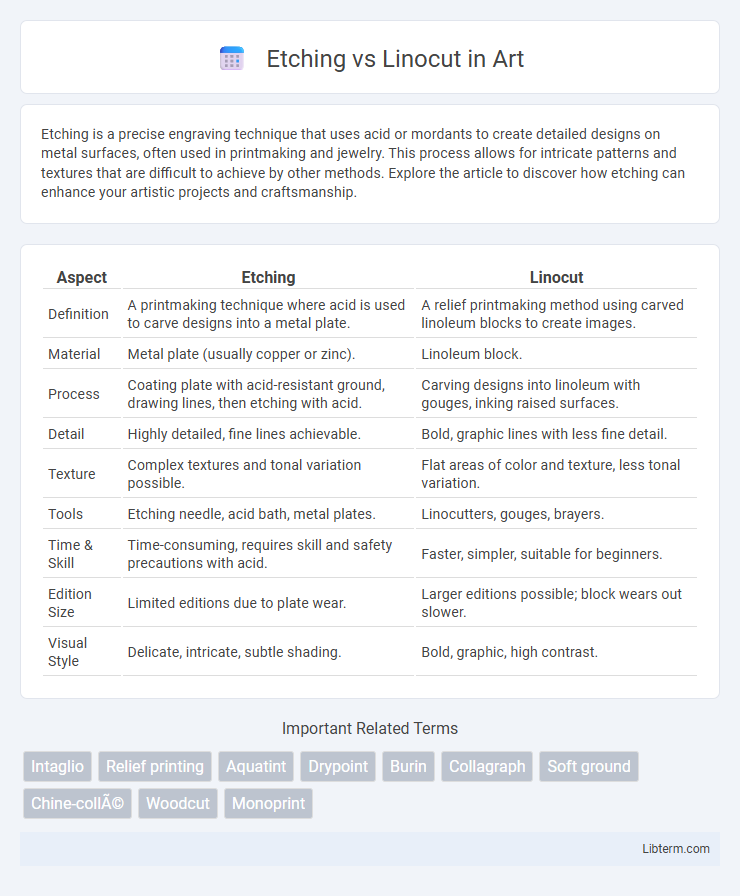Etching is a precise engraving technique that uses acid or mordants to create detailed designs on metal surfaces, often used in printmaking and jewelry. This process allows for intricate patterns and textures that are difficult to achieve by other methods. Explore the article to discover how etching can enhance your artistic projects and craftsmanship.
Table of Comparison
| Aspect | Etching | Linocut |
|---|---|---|
| Definition | A printmaking technique where acid is used to carve designs into a metal plate. | A relief printmaking method using carved linoleum blocks to create images. |
| Material | Metal plate (usually copper or zinc). | Linoleum block. |
| Process | Coating plate with acid-resistant ground, drawing lines, then etching with acid. | Carving designs into linoleum with gouges, inking raised surfaces. |
| Detail | Highly detailed, fine lines achievable. | Bold, graphic lines with less fine detail. |
| Texture | Complex textures and tonal variation possible. | Flat areas of color and texture, less tonal variation. |
| Tools | Etching needle, acid bath, metal plates. | Linocutters, gouges, brayers. |
| Time & Skill | Time-consuming, requires skill and safety precautions with acid. | Faster, simpler, suitable for beginners. |
| Edition Size | Limited editions due to plate wear. | Larger editions possible; block wears out slower. |
| Visual Style | Delicate, intricate, subtle shading. | Bold, graphic, high contrast. |
Understanding Etching and Linocut
Etching is a printmaking technique that involves using acid to create designs on a metal plate, allowing for intricate, fine lines and detailed images. Linocut involves carving a design into a linoleum block, where the raised surface is inked and pressed, producing bold, graphic compositions with strong contrast. Understanding etching highlights its capacity for subtle tonal variations, while linocut emphasizes simplicity and expressive texture.
Historical Background of Etching and Linocut
Etching originated in the early 16th century as a printmaking technique where artists used acid to carve designs into metal plates, gaining prominence during the Renaissance with masters like Albrecht Durer and Rembrandt. Linocut, developed in the early 20th century, evolved as a variant of woodcut, utilizing linoleum blocks for carving, popularized by artists such as Pablo Picasso and Henri Matisse for its simplicity and bold visual effects. Both techniques represent significant movements in printmaking history, with etching rooted in intricate detail and linocut emphasizing graphic contrast.
Essential Materials for Each Printmaking Technique
Etching requires a metal plate, typically copper or zinc, coated with an acid-resistant ground, along with acid for biting the design into the plate. Linocut uses a linoleum block, gouges for carving the design, and water-based or oil-based inks for printing. Both techniques necessitate a brayer for ink application and high-quality paper to achieve crisp, detailed prints.
Step-by-Step Process: Etching Explained
Etching involves coating a metal plate with a waxy ground resistant to acid, then drawing a design by scratching through this ground to expose the metal. The plate is submerged in an acid bath, where the acid etches the exposed metal, creating grooves that hold ink. After cleaning, ink is applied and wiped from the surface, leaving ink in the etched grooves, which is then transferred onto paper through a printing press.
Step-by-Step Process: Linocut Explained
Linocut involves carving a design into a linoleum block using specialized gouges, removing areas that will remain white or uninked in the final print. After carving, ink is applied evenly to the surface with a roller, ensuring only the raised areas receive ink. The block is then pressed onto paper or fabric either by hand or with a printing press to create the final image.
Visual Differences in the Final Prints
Etching produces highly detailed lines with a wide range of tonal values due to the acid's ability to bite into metal plates, resulting in delicate textures and intricate shading. Linocut prints display bold, graphic qualities with strong contrasts because the design is carved into a soft linoleum surface, creating clear, solid shapes and sharp edges. The final etching print often has a softer, more nuanced appearance, while linocut prints are characterized by their stark, high-contrast visual impact.
Artistic Advantages of Etching
Etching offers superior detail and fine line work compared to linocut, allowing artists to achieve intricate textures and subtle tonal variations. The technique involves using acid to create delicate grooves on metal plates, which can produce a wide range of depths and shading effects unattainable in linocut's bold, high-contrast style. This precision makes etching ideal for complex imagery, enhancing artistic expression through nuanced depth and sophisticated design.
Benefits and Limitations of Linocut
Linocut offers benefits such as ease of carving due to its soft linoleum surface, making it accessible for beginners and allowing for bold, graphic designs with sharp contrasts. The material's affordability and durability enable multiple prints without rapid wear, while its simplicity supports quick production. However, linocut has limitations including less fine detail compared to techniques like etching, and the risk of limited tonal variation due to its relief printing process.
Choosing Between Etching and Linocut
Choosing between etching and linocut depends on the desired artistic effect and technical complexity. Etching allows for intricate detail and subtle tonal variations using acid on a metal plate, making it ideal for artists seeking fine lines and rich textures. Linocut, favored for its bold, graphic qualities, involves carving into a linoleum surface and suits those who prefer a more straightforward, hands-on printmaking process.
Popular Artists and Influences in Both Techniques
Etching artists such as Rembrandt and Francisco Goya revolutionized printmaking with intricate line work and tonal variation, influencing countless modern artists in their use of acid to create detailed images on metal plates. Linocut proponents like Pablo Picasso and Henri Matisse embraced bold, graphic forms that emphasized texture and contrast, inspiring a wave of 20th-century printmakers to explore direct carving techniques on linoleum blocks. Both techniques have shaped contemporary print art by blending traditional craftsmanship with expressive, avant-garde aesthetics rooted in these influential masters.
Etching Infographic

 libterm.com
libterm.com